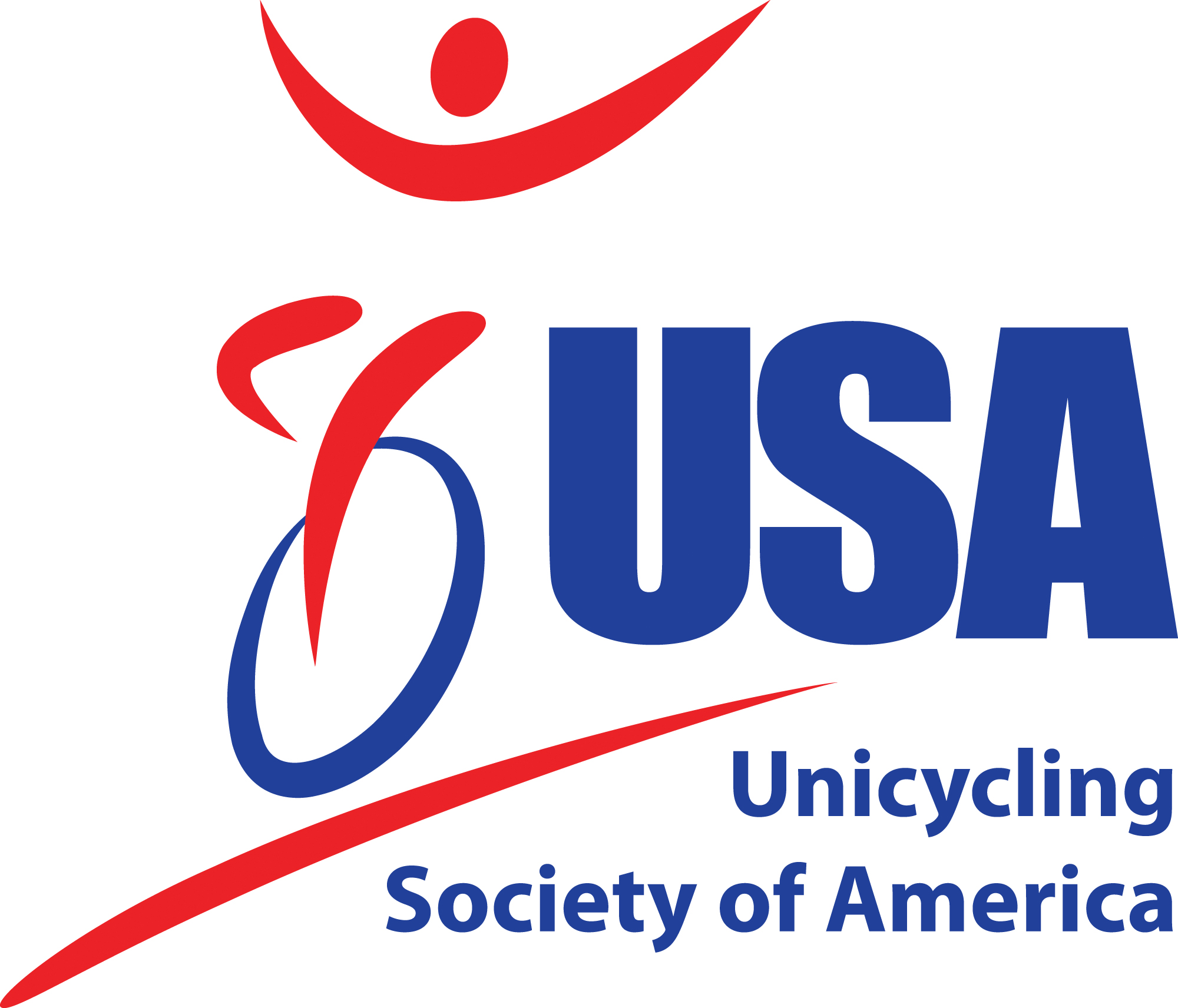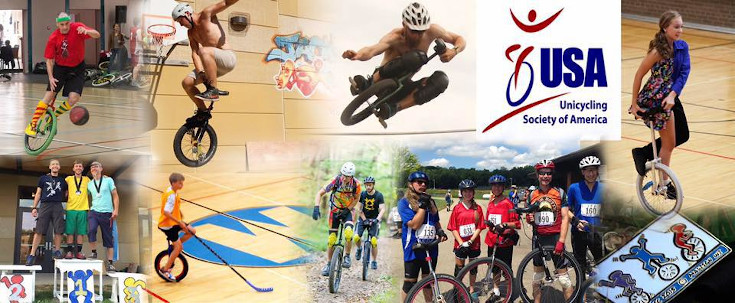- Home
- Membership
- Clubs
- Start & Run a Club
Start & Run A Club
Frequently Asked Questions About Setting Up a Unicycle Group in the U.S.
1. Getting Started
How do I begin?
If you have one person interested, you’re ready to form a club! Come up with a name and get started.
How do I choose a good name?
Many groups use their location for their name, such as the Memphis Unicycle Club, New York Unicycle Club, and so on.
Consider what acronym you’re forming (such as MUC) as you decide on a name. Avoid anything too difficult to remember or that might not appeal to families. Your new group could continue for many years, so think ahead. Use either Unicycle or Unicycling in your name, so it’s easy for people to see what your focus is.
What are the start-up costs?
It’s possible to start a group with almost no cost, especially if you meet outdoors at first.
Just print up information and begin to hand it out. As the group grows, you may want to charge an annual membership fee or consider other fund-raising possibilities. Some clubs sell t-shirts, teach classes, or do performances for payment. Some expenses might include the costs of printing, postage, space rental, insurance, and equipment.
How do I get the basic information out?
Prepare a Frequently Asked Questions sheet. Give people general information about unicycling and about your club. If you’d like a sample of a club FAQ to base yours on, please send an email to carolmclean33@gmail.com.
What about equipment?
People often want to try out a unicycle before they’re willing to buy one.
You can allow people to try your personal unicycles, have the club purchase unicycles to use as loaners at practice, or rent them out. You’ll need adjustable 20-inch unis for most new riders and 16-inch unis for young children.
Some groups always bring extra unicycles to practice sessions so anyone can try them. Others have potential new riders contact them in advance, so they can bring a loaner to practice.
Having unis on hand can be a great way to recruit new riders, but it can be a challenge to accommodate everyone. Sometimes seatposts can’t be adjusted to fit, and riders simply can’t try a unicycle that’s too tall for them. To avoid this problem, have several seats with seatposts already attached in a variety of sizes to ensure that you have a unicycle that will fit your visitors.
You may also want to set a maximum for the number of “free” trials. Expect riders to purchase their own unicycles after one or two free sessions. They will learn faster on their own, and unicycles are very inexpensive when compared with just about any other sporting equipment. Plus, unicycles generally last a lifetime and require very little maintenance. It’s a good investment, so encourage new riders to purchase their own as soon as possible. You can even consider offering a buy-back plan, agreeing to buy back a new uni that someone wants to sell. It’s very likely that any unicycle you buy back could be sold again immediately. There always seems to be a good market for slightly used unicycles.
What ages should I allow?
All ages. That’s important to your success. However, you may want to allow children to participate only when their parents are on hand. It’s too easy to become a babysitting service, and there’s usually too much going on to watch each child at all times.
Encourage adults to learn. Families find that unicycling is a great activity that they can do together. If adults participate, they are much more likely to come to practice sessions. If they don’t want to ride, encourage adults to help out by assisting other riders.
Keep the teens interested. Bring in advanced riders if possible or have them watch unicycling videos for inspiration. Sponsor special events, such as short performances, workshops, or competitions to keep riders actively involved.
Provide new challenges often, such as an ultimate wheel, giraffes, juggling and riding, a trick bike, ramps, or whatever else is available.
What about a membership form?
It may be a good idea to have riders register and sign a waiver even if you aren’t charging a membership fee. A sample membership form is available upon request. Note that to be covered by Unicycling Society of America insurance, a waiver is mandatory.
How do I advertise?
Prepare simple business cards with the group name and a contact person and/or website. Cards can be printed from a home computer or purchased from a small printer. Have them handy whenever you ride.
It’s easy to put up informational signs in public places, such as libraries or community centers. Make them attractive and brief and include your phone number and/or email address. Ask for permission, if necessary, so the signs aren’t removed.
Local newspapers are often willing to print a short article to announce your new group or to let people know when and where practices are held.
What about a club logo?
Go for it. If necessary, find someone to help with the design—young artists often are willing to work on a logo for little cost. The best logos are usually simple, attractive, and family-friendly. Remember to think ahead. A good logo can last for many years.
Should we have a club t-shirt?
Having a club t-shirt is a great way to establish your club’s identity in the community. T-shirt sales can also be a good way to raise money for your new club.
Find someone willing to provide a t-shirt design. Depending on your needs, include the club name or make it generic to unicycling if it’s a way to raise funds. Unicyclists often buy t-shirts offered for sale by other clubs.
Young artists might be willing to provide a t-shirt design for little cost. Check online or with a local company to find out the specifics for the artwork required. If you ask your group members to order in advance, you may be able to order enough t-shirts on each run to get a quantity discount. The t-shirt color should appeal to both males and females.
If your t-shirt is going to be used as the official performance outfit for your group (such as in a parade), be sure you get a very high quality t-shirt—one that will hold up well in the rain.
You may want a design on both sides, which usually adds quite a bit to the cost per shirt but provides more recognition for your group. Shirts that are a lighter color (white, gray) are often less expensive than dark color shirts. Special inks also add to the cost.
What other fundraisers are available?
Besides selling t-shirts or other unicycling-related items, clubs often do parades or shows to earn money. Most communities are glad to have a unicycle group willing to perform. Some clubs earn anywhere from $100 to $500 by participating in a parade or show. In order to charge a parade fee, the group should have a set costume, a good parade routine, and should be able to guarantee that enough riders and support people will participate.
Classes and equipment rentals are other ways to raise money. Many clubs also charge a membership fee to help cover the costs of space rental and insurance.
2. Safety Issues
What safety concerns are there?
Unicycling is surprisingly safe, though it appears dangerous to many people. Since unicycling is usually done in an upright position and at low speeds, the risk of injury is usually less than in many other sports, including bicycling.
Common initial complaints are bruises on the legs (from getting hit with pedals or other parts of the unicycle) and sore knees. These problems usually disappear as the rider improves, but sore knees may be the result of the unicycle seat being too low. Raise the seat so the rider’s legs extend almost fully during each revolution.
Some clubs require participants riding the club’s loaner unicycles to wear safety gear (helmet and wristguards). Some clubs require the use of helmets at all times, while others don’t require them at all. However, riders can fall and hit their head when practicing skills such as riding backward. It’s also possible for any rider to hit his head on a wall or other surface when practicing skills nearby.
Wristguards are a good idea for many riders. Some riders have broken bones in their wrists after falling and landing on their hands.
One of the best ways to prevent an accident is very simple—make sure riders tie their shoelaces securely. Countless accidents have occurred when a rider’s shoelace got caught in a crank arm and pulled the rider off unexpectedly.
Do I have to watch all the riders all the time?
It’s impossible for club directors to keep an eye on everyone. Be sure to make it clear that parents are responsible for their kids at all times. Some clubs allow kids to be at practice without a parent, but parents must be aware that the adults at practice cannot assume responsibility for their kids’ safety.
Rely on teens or other adults to help make sure everyone is operating safely. Make sure your group’s rules are clear before safety problems occur. If kids have trouble following the rules, deal with the problem by talking with parents or suspending the rider’s participation for a week or two. Allowing problems to grow could jeopardize others’ safety or the integrity of your group.
3. Space
Where do I get space?
Club members or interested participants often have connections at community centers or churches. This can help in establishing a relationship with these places to secure indoor or outdoor riding space.
Some schools and churches will allow groups to reserve practice space for no cost. While it’s sometimes difficult to reserve a gym, you may be able to reserve a cafeteria. Tile floor is easy to ride on, and it’s certainly smoother than pavement.
Some clubs trade to get free practice space. They will do a free performance or teach classes. Classes are often one-hour sessions for six consecutive weeks. The sponsoring organization usually charges a small amount for the classes, and they keep that payment in exchange for providing the practice space for the group.
Will unicycles harm gym floors?
Usually not. This reference letter may help ease the worry of a prospective venue owner. Restrict indoor riding to non-marking tires. If you notice that you have left tire marks behind, erase them.
How do I guarantee that we don’t get kicked out?
Respect the space at all times. Make sure all your members know that it’s difficult to get space and easy to lose it. Never leave trash behind. Put back anything that you’ve moved around. Treat the staff members very well and make sure they have no complaints about your group.
4. Business Issues
What about insurance?
Many organizations that offer practice space will require groups to provide proof of insurance.
This is usually general liability insurance that covers possible damage to the practice space. Often this insurance is also required of groups before they can participate in parades. In that case, the insurance is protecting spectators from any harm that could result from the parade (for example, if someone on a tall unicycle falls on a spectator and harms them).
Insurance laws, requirements, and costs vary from state to state. You can start to find out what’s available by checking with a local insurance agency. Some clubs have found that the cost of general liability insurance is about $300 annually.
Clubs affiliated to the Unicycling Society of America have the benefit of free liability insurance – more details here: http://uniusa.org/membership/insurance/.
Does insurance cover any accidents that may happen to club members?
Usually, club insurance does not cover accidents that involve club members if they are hurt. If someone is at practice and breaks a wrist, for example, your club insurance will not pay any medical costs. Those costs are up to the individual. Your club membership form should make it clear to your participants that they are riding at their own risk.
What about nonprofit status?
Clubs must apply to the state if they want to get nonprofit status. There is usually a fee, which varies from state to state. Some states require a larger fee up front, and then smaller annual fees. Check your state guidelines for more information about nonprofit status.
In some cases, organizations may require clubs to provide proof of their nonprofit status (and/or insurance) to participate in parades. (If the club has nonprofit status, parade organizers do not charge the group. Because most groups that participate in parades are for-profit ventures, they usually must pay an entry fee. Unicycling groups usually do not pay a fee and actually charge a fee for their participation in parades.)
Some clubs pursue nonprofit status for personal liability protection. Check with your state and with local insurance companies for more information.
5. Club Organization and Officers
Do I need to establish a Mission/Vision Statement?
A mission/vision statement can serve as a foundation to build your club with a specific focus. This can serve to give your group more credibility in your community. For example, is your primary interest to promote youth development, to develop a highly skilled performance team, or to provide a family-oriented form of exercise? A mission statement lets everyone know where you’re headed and keeps the group focused.
What about club officials?
There are many ways to set up the leadership positions of a group. Groups are more successful if several people are sharing the leadership roles. Your group will probably have to experiment to find what works best for you.
One way is to ask for volunteers for specific positions. For example, you could have the following leadership positions:
- Club director(s)—overall responsibility for the operation of the group
- Events director—organizes special events, such as regional competitions
- Practice director—finds practice space
- Performance director—contact person and organizer for parades or other performances
- Financial director—keeps track of club income and expenses
- Communications director—updates website, sends out news updates
- Equipment director—keeps track of club equipment and maintains it
- Trainers/Instructors—help teach riding skills
- Managers—younger riders (14 to 18) willing to help teach, perform miscellaneous tasks
Some groups have monthly meetings to discuss all the issues that face the group. These can be informal and even held over lunch or dinner. Ask one person to be responsible for taking notes and sending them out afterwards, so you have a written record of your decisions.
Do club officers need additional personal insurance?
It’s a good idea for a volunteer in any organization to check with his or her insurance agent to find out if additional insurance is necessary. Often, the insurance can be added to an existing policy without much extra cost.
6. Teaching Various Riding Styles
How do I help new riders learn?
You’ll probably find that teaching people to ride will be a long-term commitment. You’ll always need to recruit new riders, and, so far, there’s no easy, sure-fire way to learn to ride. It takes time and practice and determination.
While each individual has his or her own learning style, it’s almost guaranteed that anyone who tries to ride will need some amount of help.
Some people will require much more help than others. It’s wise to offer some help but to encourage new riders to either work with a buddy or use a wall for support rather than relying on club leaders for constant assistance. Parents, too, can provide some help, but offer some training for them so they know how to help a new rider.
Clubs affiliated to the Unicycling of America should consider taking advantage of the USA Coaching Program that pairs certified coaches with new or developing clubs in order to help teach new skills – more details here: http://uniusa.org/learn/usa-coaching-program/.


